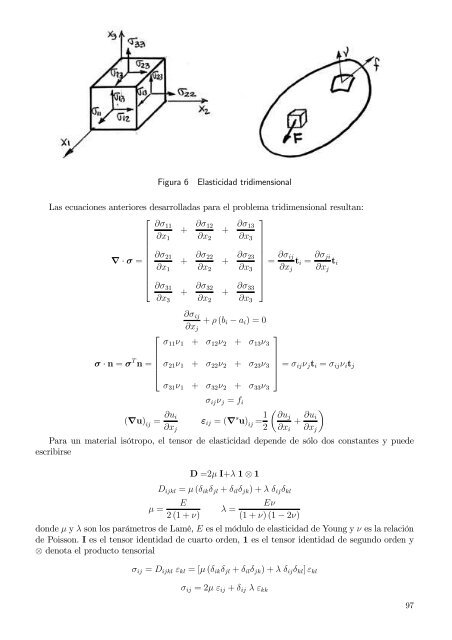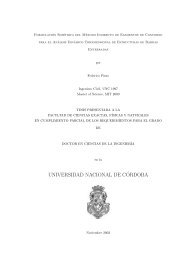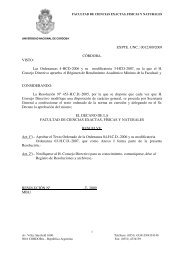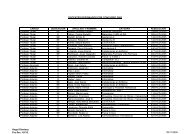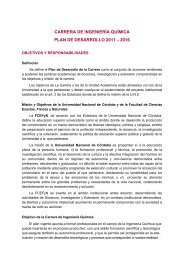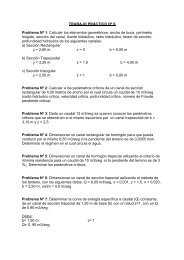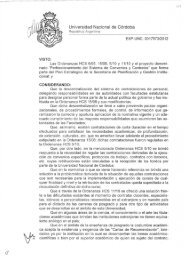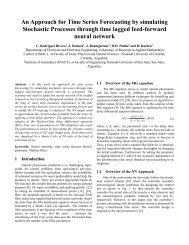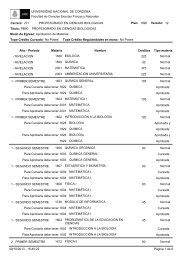Capítulo 1 Métodos de residuos ponderados Funciones de prueba ...
Capítulo 1 Métodos de residuos ponderados Funciones de prueba ...
Capítulo 1 Métodos de residuos ponderados Funciones de prueba ...
Create successful ePaper yourself
Turn your PDF publications into a flip-book with our unique Google optimized e-Paper software.
Figura 6<br />
Elasticidad tridimensional<br />
Las ecuaciones anteriores <strong>de</strong>sarrolladas para el problema tridimensional resultan:<br />
⎡<br />
∂σ 11<br />
+ ∂σ 12<br />
+ ∂σ ⎤<br />
13<br />
∂x 1 ∂x 2 ∂x 3<br />
∂σ 21<br />
∇ · σ =<br />
+ ∂σ 22<br />
+ ∂σ 23<br />
= ∂σ ij<br />
t i = ∂σ ji<br />
t i<br />
∂x 1 ∂x 2 ∂x 3<br />
∂x j ∂x j<br />
⎢<br />
⎣ ∂σ 31<br />
+ ∂σ 32<br />
+ ∂σ ⎥<br />
⎦<br />
33<br />
∂x 3 ∂x 2 ∂x 3<br />
⎡<br />
σ · n = σ T n =<br />
⎢<br />
⎣<br />
∂σ ij<br />
∂x j<br />
+ ρ (b i − a i ) = 0<br />
⎤<br />
σ 11 ν 1 + σ 12 ν 2 + σ 13 ν 3<br />
σ 21 ν 1 + σ 22 ν 2 + σ 23 ν 3<br />
⎥<br />
⎦ = σ ijν j t i = σ ij ν i t j<br />
σ 31 ν 1 + σ 32 ν 2 + σ 33 ν 3<br />
σ ij ν j = f i<br />
(∇u) ij<br />
= ∂u i<br />
∂x j<br />
ε ij = (∇ s u) ij<br />
= 1 2<br />
( ∂uj<br />
+ ∂u )<br />
i<br />
∂x i ∂x j<br />
Para un material isótropo, el tensor <strong>de</strong> elasticidad <strong>de</strong>pen<strong>de</strong> <strong>de</strong> sólo dos constantes y pue<strong>de</strong><br />
escribirse<br />
D =2µ I+λ 1 ⊗ 1<br />
D ijkl = µ (δ ik δ jl + δ il δ jk ) + λ δ ij δ kl<br />
E<br />
Eν<br />
µ =<br />
λ =<br />
2 (1 + ν) (1 + ν) (1 − 2ν)<br />
don<strong>de</strong> µ y λ son los parámetros <strong>de</strong> Lamé, E es el módulo <strong>de</strong> elasticidad <strong>de</strong> Young y ν es la relación<br />
<strong>de</strong> Poisson. I es el tensor i<strong>de</strong>ntidad <strong>de</strong> cuarto or<strong>de</strong>n, 1 es el tensor i<strong>de</strong>ntidad <strong>de</strong> segundo or<strong>de</strong>n y<br />
⊗ <strong>de</strong>nota el producto tensorial<br />
σ ij = D ijkl ε kl = [µ (δ ik δ jl + δ il δ jk ) + λ δ ij δ kl ] ε kl<br />
σ ij = 2µ ε ij + δ ij λ ε kk<br />
97


